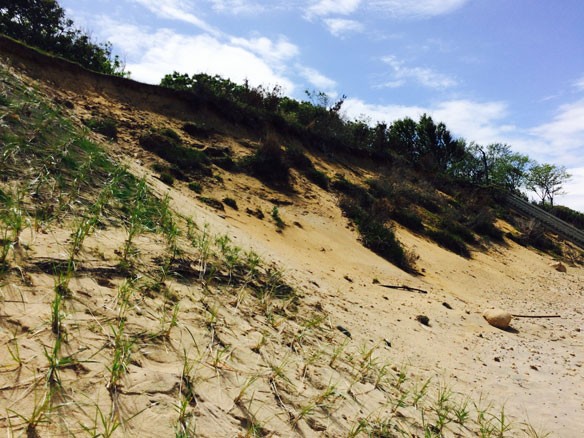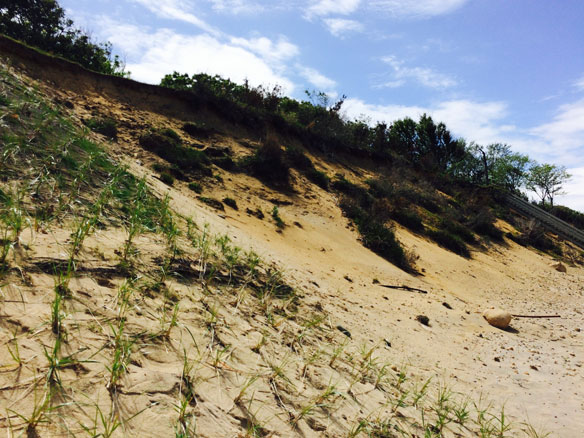
Coastal restoration. Photograph: © SAF — Coastal Care
Excerpts;
The Lake Erie peninsula is in danger of breaking in two, despite millions of taxpayer dollars spent trying to preserve it…
Read Full Article and View News Video, WTAE (07-18-2016)
Economy Winner, Environment Loser in Renourishment; Pensacola News Journal (12-02-2015)
Editorial: Beach Replenishment is No Cure-All, Asburry Park Press (05-14-2015)
Is Beach Renourishment Worth The Money? WWAY News (02-16-2015)
A Beach Project Built on Sand; By Robert S. Young, PhD; The New York Times (08-22-2014)
Gov. Andrew M. Cuomo announced a $207 million plan to dredge millions of tons of sand off the south shore of Long Island and spread it along the beaches and dunes. It is a colossal waste of money and another consequence of the nation’s failure to develop a coherent plan to address the risks from storms faced by states along the eastern seaboard and gulf coast…
Piling sand to stop erosion ultimately made the land sink, study says, NOLA (12-26-2015)
“Seawalls Kill Beaches,” Open Letters by Warner Chabot And Rob Young; (10-03-2014)
A report and open letter from coastal geologists Warner Chabot and Rob Young, presented to the Ocean Protection Council (OPC) meeting in Sacramento, held on August 26th, 2014…
“Engineering away our natural defenses: An analysis of shoreline hardening in the US,” A Study by By Rachel K. Pittman, ResearchGate (08-08-2015)
Rapid coastal population growth and development are primary drivers of marine habitat degradation. Although shoreline hardening, a byproduct of development, can accelerate erosion and loss of beaches and tidal wetlands, it is a common practice globally. 22,842 km of continental U.S. shoreline, 14% of the total, has been hardened…
A Fiscal Analysis of Shifting Inlets and Terminal Groins in North Carolina, By Rob Young Director of the Program for the Study of Developed Shorelines at Western Carolina University (01-28-2011)
The debate about terminal groins, shore-perpendicular structures built at inlets in attempt to slow erosion, is worth keeping an eye on, whether you live in western North Carolina or in a coastal community, because it could cost you and our state a pretty penny…
Coastal erosion needs our attention, South Coast Today (01-04-2016)
Living shorelines a more natural approach to preventing coastal erosion; (05-18-2016)
For centuries, large bulkheads have been used to help control erosion along coastlines. More recent research suggests that a natural approach may be a better alternative. Having nature on your side, especially during a storm or hurricane, is proven to provide better protection from coastal erosion…
Rethinking Living Shorelines, By Orrin H. Pilkey, Rob Young, Norma Longo, and Andy Coburn;Program for the Study of Developed Shorelines / Western Carolina University, March 1, 2012, Nicholas School of the Environment, Duke University
In response to the detrimental environmental impacts caused by traditional erosion control structures, environmental groups, state and federal resource management agencies, now advocate an approach known as “Living Shorelines”that embraces the use of natural habitat elements such as indigenous vegetation, to stabilize and protect eroding shorelines.
NOAA Study Finds Marshes, Reefs, Beaches Can Enhance Coastal Resilience, NOAA (04-29-2015)
“North Carolina: The Beaches Are Moving,” A Video featuring Orrin Pilkey, PhD
World famous coastal geologist Orrin H. Pilkey takes us to the beach and explains why erosion has become a problem…









